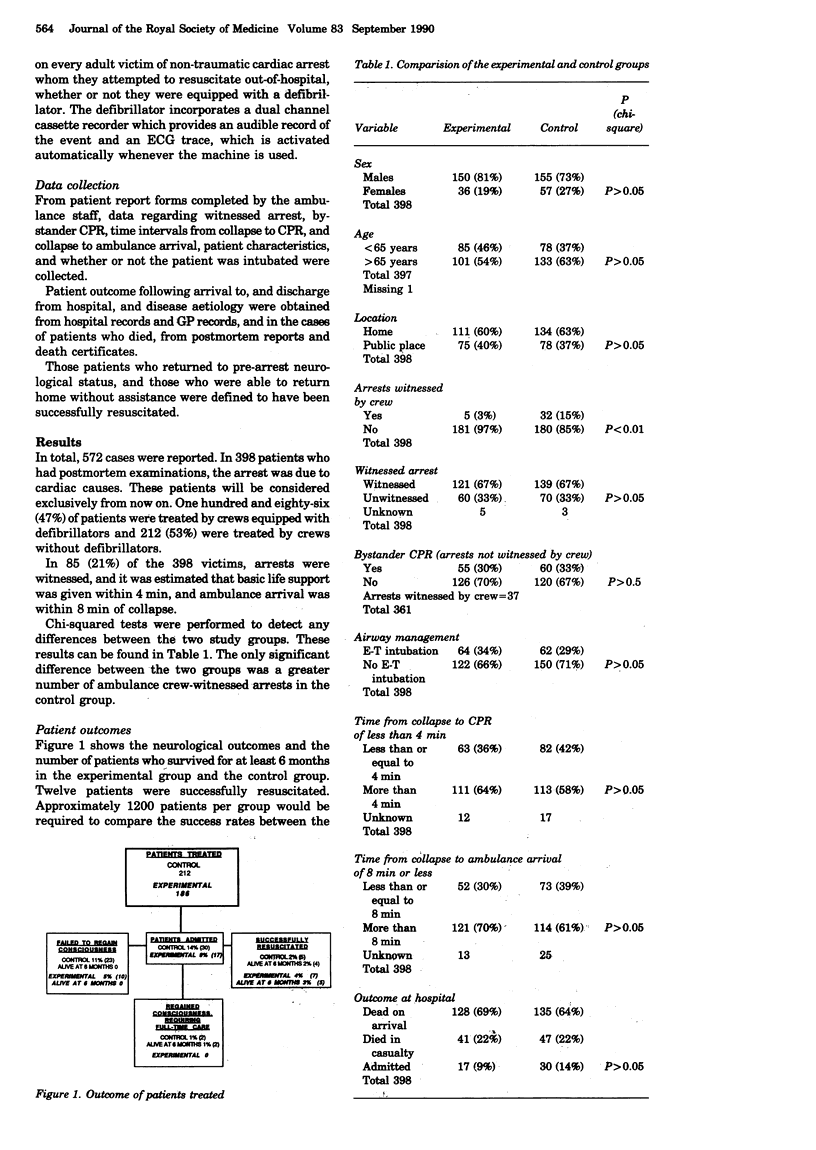Abstract
This controlled trial was performed in London and compared outcomes of patients treated by ambulance staff using either basic life support alone or an automated external defibrillator (AED) as an adjunct to basic life support. Five of the 212 (2%) patients were successfully resuscitated by crews using basic life support alone, compared with seven of 186 (4%) patients treated by crews equipped with the AED. Neurological outcomes in the AED group were better. However, meaningful statistical comparisons are not possible with so few survivors. The AED used (Lifepak 200, PhysioControl Corp) was found to be sensitive and specific, and ambulance staff operated the defibrillator correctly. The use of AEDs in an option to maximize the provision of defibrillators in the community and could readily be incorporated into basic ambulance training.
Full text
PDF


Selected References
These references are in PubMed. This may not be the complete list of references from this article.
- Cobb L. A., Alvarez H., 3rd, Kopass M. K. A rapid response system for out-of-hospital cardiac emergencies. Med Clin North Am. 1976 Mar;60(2):283–293. doi: 10.1016/s0025-7125(16)31909-5. [DOI] [PubMed] [Google Scholar]
- Cummins R. O., Eisenberg M. S., Hallstrom A. P., Hearne T. R., Graves J. R., Litwin P. E. What is a "save"?: Outcome measures in clinical evaluations of automatic external defibrillators. Am Heart J. 1985 Dec;110(6):1133–1138. doi: 10.1016/0002-8703(85)90002-x. [DOI] [PubMed] [Google Scholar]
- Cummins R. O., Eisenberg M. S., Litwin P. E., Graves J. R., Hearne T. R., Hallstrom A. P. Automatic external defibrillators used by emergency medical technicians. A controlled clinical trial. JAMA. 1987 Mar 27;257(12):1605–1610. [PubMed] [Google Scholar]
- Diack A. W., Welborn W. S., Rullman R. G., Walter C. W., Wayne M. A. An automatic cardiac resuscitator for emergency treatment of cardiac arrest. Med Instrum. 1979 Mar-Apr;13(2):78–83. [PubMed] [Google Scholar]
- Eisenberg M. S., Bergner L., Hallstrom A. Cardiac resuscitation in the community. Importance of rapid provision and implications for program planning. JAMA. 1979 May 4;241(18):1905–1907. doi: 10.1001/jama.241.18.1905. [DOI] [PubMed] [Google Scholar]
- Eisenberg M. S., Bergner L., Hallstrom A. Cardiac resuscitation in the community. Importance of rapid provision and implications for program planning. JAMA. 1979 May 4;241(18):1905–1907. doi: 10.1001/jama.241.18.1905. [DOI] [PubMed] [Google Scholar]
- Eisenberg M., Bergner L., Hallstrom A. Paramedic programs and out-of-hospital cardiac arrest: I. Factors associated with successful resuscitation. Am J Public Health. 1979 Jan;69(1):30–38. doi: 10.2105/ajph.69.1.30. [DOI] [PMC free article] [PubMed] [Google Scholar]
- Rosenthal E., Carroll D., Vincent R., Chamberlain D. A. Automated external defibrillation: laboratory evaluation. Int J Cardiol. 1984 Apr;5(4):441–447. doi: 10.1016/0167-5273(84)90079-2. [DOI] [PubMed] [Google Scholar]
- Roth R., Stewart R. D., Rogers K., Cannon G. M. Out-of-hospital cardiac arrest: factors associated with survival. Ann Emerg Med. 1984 Apr;13(4):237–243. doi: 10.1016/s0196-0644(84)80470-9. [DOI] [PubMed] [Google Scholar]
- Rowley J. M., Mounser P., Garner C., Hampton J. R. Advanced training for ambulance crews: implications from 403 consecutive patients with cardiac arrest managed by crews with simple training. Br Med J (Clin Res Ed) 1987 Nov 28;295(6610):1387–1389. doi: 10.1136/bmj.295.6610.1387. [DOI] [PMC free article] [PubMed] [Google Scholar]
- Stults K. R., Brown D. D., Kerber R. E. Efficacy of an automated external defibrillator in the management of out-of-hospital cardiac arrest: validation of the diagnostic algorithm and initial clinical experience in a rural environment. Circulation. 1986 Apr;73(4):701–709. doi: 10.1161/01.cir.73.4.701. [DOI] [PubMed] [Google Scholar]
- Stults K. R., Brown D. D., Schug V. L., Bean J. A. Prehospital defibrillation performed by emergency medical technicians in rural communities. N Engl J Med. 1984 Jan 26;310(4):219–223. doi: 10.1056/NEJM198401263100403. [DOI] [PubMed] [Google Scholar]
- Walters G., Glucksman E. Planning a pre-hospital cardiac resuscitation programme: an analysis of community and system factors in London. J R Coll Physicians Lond. 1989 Apr;23(2):107–110. [PMC free article] [PubMed] [Google Scholar]
- Walters G., Glucksman E. Retention of skills by advanced trained ambulance staff: implications for monitoring and retraining. BMJ. 1989 Mar 11;298(6674):649–650. doi: 10.1136/bmj.298.6674.649. [DOI] [PMC free article] [PubMed] [Google Scholar]
- Warner L. L., Hoffman J. R., Baraff L. J. Prognostic significance of field response in out-of-hospital ventricular fibrillation. Chest. 1985 Jan;87(1):22–28. doi: 10.1378/chest.87.1.22. [DOI] [PubMed] [Google Scholar]


